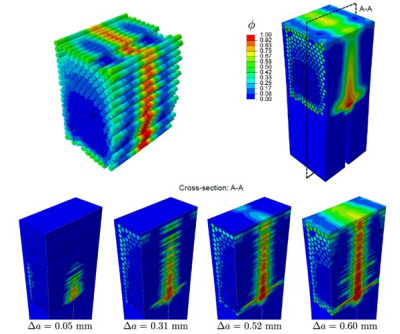News
New paper: Phase field predictions of 3D microscopic fibre bridging behaviour of composite materials
8 February 2022

New paper with my collaborator Emilio Martínez Pañeda, Ph.D. (Imperial). Do you know why fibres are the ubiquitous reinforcement in many biological systems (articular cartilage, wood, etc.) and modern engineering structures (aircraft, wind turbine blade, etc.)?
In this paper, we have revealed some key toughening mechanisms in fibre-reinforced composites. Fibres bridge the gap between two adjacent crack surfaces and delay crack tip opening. A significant amount of fracture energy is absorbed by fibre–matrix debonding, fibre pull-out, and fibre breakage, thereby notably increasing the material fracture toughness.
We have presented a new computational framework to investigate the role of microstructural bridging on the fracture toughness of composite materials. This is achieved by coupling the phase field (PF) fracture and cohesive zone model (CZM). We found that the total fracture toughness of fibre-reinforced composite materials increases with the increasing fibre volume fraction, well above rule of mixtures.
The main novel contributions of this work are: (i) the pioneering use of a combined PF-CZM model to predict microscale bridging behaviour; (ii) the analysis, for the first time, of the effect of reinforcement (grain, fibre) toughness on crack growth resistance; and (iii) the characterisation of the previously unknown effect on the fracture toughness of various microstructures including bridged-grain, brick-and-mortar, and 3D fibre bridging. Our results show that the modelling framework presented provides new pathways for an efficient and accurate design of damage-tolerant composite materials and structures.
50 days' free access via this link: https://lnkd.in/eMWzVkFY
https://doi.org/10.1016/j.compstruct.2022.115242
| Contact: | Wei Tan |
| People: | Wei TAN |
Updated by: Wei Tan

